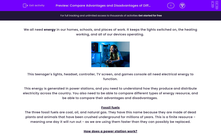We all need energy in our homes, schools, and places of work. It keeps the lights switched on, the heating working, and all of our devices operating.

This teenager's lights, headset, controller, TV screen, and games console all need electrical energy to function.
This energy is generated in power stations, and you need to understand how they produce and distribute electricity across the country. You also need to be able to compare different types of energy resource, and be able to compare their advantages and disadvantages.
Fossil fuels
The three fossil fuels are coal, oil, and natural gas. They have this name because they are made of dead plants and animals that have been crushed underground for millions of years. This is a finite resource - meaning one day it will run out - as we are using them faster than they can possibly be replaced.
How does a power station work?
.jpg)
A coal power station works by burning the coal. As coal is full of carbon, it contains a large amount of chemical energy and will burn slowly. It will also transfer this chemical energy into heat as it burns. This heat energy is then used to boil water and turn it into steam.
The steam is then forced through turbines, where another energy transfer occurs - the turbines are forced to rotate, converting the heat energy into kinetic energy.
Finally, the turbines are attached to a generator, which is a giant magnet surrounded by coils of wire. The rotation of the magnet inside the coil will induce a voltage - this essentially means that electricity can now flow. So the final energy transfer is kinetic energy to electrical energy.
The thing that all power stations have in common, regardless of whether they are fossil fuel or an alternative resource, is that they force a turbine to rotate a generator, in order to transfer kinetic energy into electrical energy.
Alternatives to fossil fuels
There are many alternatives to fossil fuels, and there is an inceasing need for them, as fossil fuels are non-renewable (meaning they will eventually run out), and they release carbon dioxide when they burn, which contributes to the Greenhouse Effect.
You need to be able to compare the advantages and disadvantages of various alternative energy resources. This is summarised in the table below.
| Energy resource | How it works | Advantages | Disadvantages |
| Wind | A wind turbine spins as the wind blows and transfers the kinetic energy of the wind directly into electricity, as they contain a generator. | Do not take up a lot of space. The land underneath can still be used. | Unreliable - they do not work if the wind speed is too fast or too slow. |
| Hydroelectricity | Water is stored in a dam. It is made to flow downhill, rotating a turbine attached to a generator. | Can easily control the output of electricity, and can store it for when it's needed. | Increases risk of flooding; destroys habitats. |
| Tidal | The movement of the tides rotates a turbine attached to a generator. | Reliable - tides will always go in and go out every day. | Difficult to repair and can kill fish. |
| Nuclear | Nuclear reactions in a reactor produce enormous amounts of heat. This boils water to turn it into steam. The rest of the process is the same as a fossil fuel power station. | Produces huge amounts of energy from a very small amount of fuel. | Nuclear waste has to be sealed and buried, and then takes thousands of years to safely decay. Nuclear is also non-renewable. |
| Solar | Solar panels convert sunlight directly into electricity. | Produces no pollution at all. | Unreliable - does not work when the sun is not shining. |
| Biomass | Plants and animal waste are burned to turn water into steam. The rest of the process is the same as a fossil fuel power station. | Makes use of waste material. | Releases carbon dioxide when burned. |
| Geothermal | Cold water is pumped underground onto hot rocks. This turns water into steam, which is pumped back up the the surface of the ground, and turns the turbine. | Doesn't take up much space and is always available. | Very restricted to where you can build this type of station, as it only works in volcanic areas. |
Have a go at this activity, where you will weigh up the pros and cons of each resource, and compare them head-to-head









